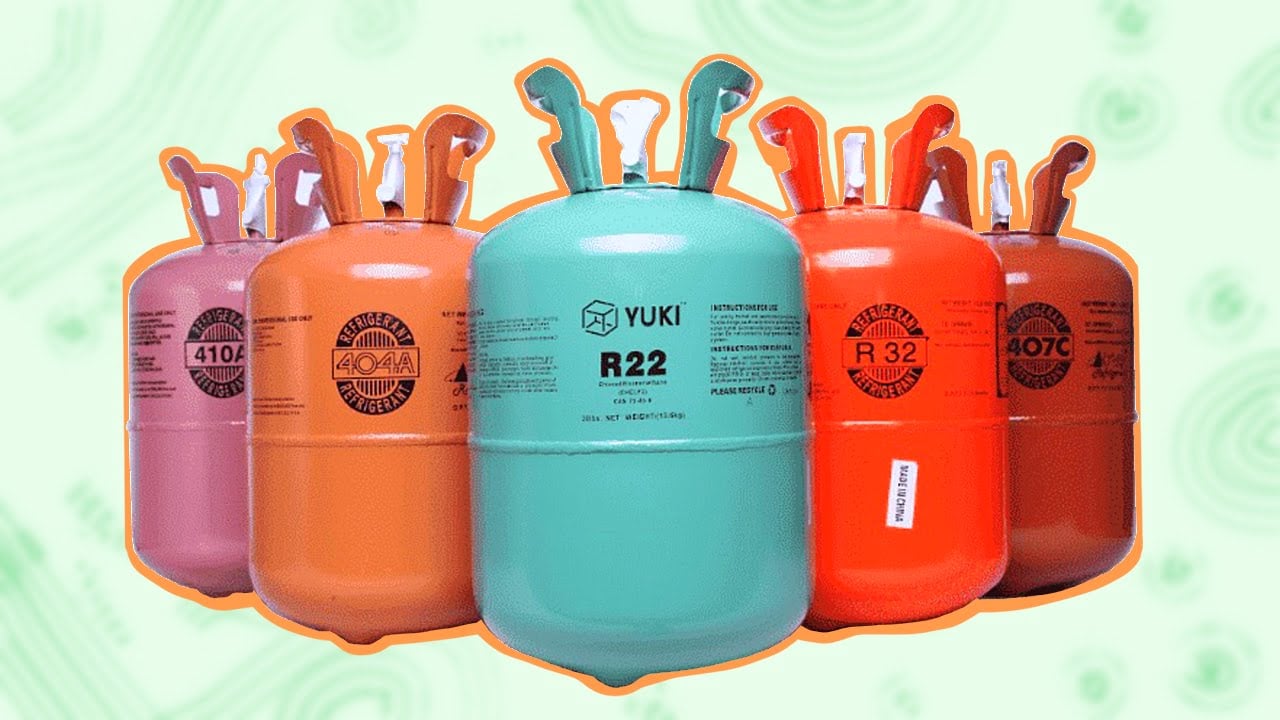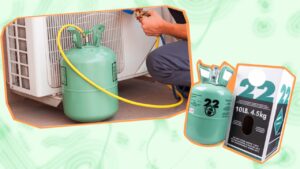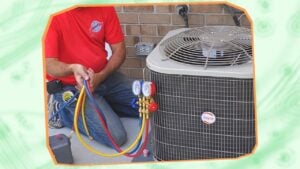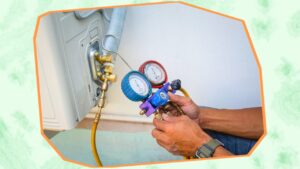R22 or chlorodifluoromethane is an air conditioning refrigerant that was once extensively used in air conditioners, car AC systems, heat pumps, and other refrigeration devices to absorb and remove heat. However, in recent years, it has been declared as a global environmental hazard.

If your cooling systems were installed in or before 2010, they likely use R22, also known as Freon. This greenhouse gas, which goes by the chemical name of hydrochlorofluorocarbon 22 (HCFC-22), has become a cause of serious concern as it results in global warming and depletion of the ozone layer.
So, if your HVAC units use an R22 refrigerant, this article is for you. Here’s your complete guide on this coolant.
Why Do You Need A Refrigerant?

Before I delve into details, I’m sure some of you are wondering what the purpose of a refrigerant is. Well, let me tell you more about it.
A refrigerant is a chemical inside the HVAC unit’s compressor that changes from gaseous to liquid form and vice versa. It is responsible for the heating and cooling which occurs in your heating, ventilation, and air conditioning systems.
R22 Freon has been one of the most popular refrigerant options, used extensively in central air conditioners and heating systems. However, as of January 2020, the Environmental Protection Agency (EPA) banned the production and import of this substance as it was found to be detrimental to the Earth’s ozone layer.
Companies that repair units containing R22 were asked to use only repurposed or recycled ones to maintain the AC unit. Without refrigerants, your HVAC systems wouldn’t function properly. So, if there is any problem with your refrigerant, it is best to let an EPA-certified HVAC technician handle it.
Why Was R22 Banned From The United States?
In 1987, several global agencies around the world, including the United States Environmental Protection Agency, created the Montreal Protocol. According to the terms of the agreement, a timeline was established to phase out the production and import of harmful chemicals.
This was done to protect the ozone layer, which forms a barrier between harmful UV radiation and the Earth. The rise in greenhouse gases combined with ozone depletion spells danger for the planet, as it can result in skin cancer, reduce agricultural productivity, and disrupt marine life.
R22 Freon is considered highly toxic and if it leaks, it can damage the environment. As a result, from 2010 onwards, there was a ban on using R22 as a refrigerant in any heat or air conditioning system.
Thus, to protect the ozone layer and mitigate the adverse impact of global climate change, the import and manufacture of R22 has become entirely illegal.
Is R22 Still Available?
The Montreal Protocol and the Clean Air Act (United States) have prohibited companies from manufacturing R22. Hence, R22 is available today only in reused and recycled form.
However, homeowners have not been asked to discard their systems containing R22. The presence of R22 in air conditioning units is not a problem in itself. But, the problem arises in case of a leak since this refrigerant is released into the environment.
So, homeowners are advised to service existing air conditioners and hire experienced EPA-certified technicians for repairs if the system malfunctions.
How To Find Out Whether Your HVAC System Uses R22?
Now that you know what is R22 and why it is so dangerous for the environment, it is time to check whether your air conditioning system uses this refrigerant. How? I’ll tell you all about it.
1. Check The Owner’s Manual
Look around in the cupboard for your device’s manual, which usually carries all the information. If the R22 refrigerant is used in the unit, it will be labeled as HCFC-22.
2. Inspect The Unit
The outdoor unit or compressor of the air conditioner will have a nameplate with all the details about it. So, check it out.
3. Hire A Technician
An experienced HVAC technician will inspect your unit and figure out whether it uses R22. The best part about hiring a technician is that they can answer all your questions about the refrigerant used in your existing equipment and how it carries global warming potential.
What To Do If Your System Uses R22?
If your existing system uses R22, it may be a cause of concern, given the Freon ban. However, let me ease your worries. A typical air conditioner is a closed system and the refrigerant passes through a well-secured loop. It doesn’t deplete like gas depletes when the car runs. As a result, you won’t need a new R22 refrigerant at regular intervals.
That being said, if there is a refrigerant leak in your HVAC system, it can lead to a bit of trouble. If your air conditioner or heat pump is not functioning properly and you consistently incur high energy bills, it is a sure-shot sign of a refrigerant leak.
Generally speaking, you will have two available options in case of a leak:
- Buy a new air conditioner
- Add R22 to the existing system
What Are The Alternatives To R22?
If you look at some of the best air conditioners manufactured after 2010, you will realize that they use a relatively safer alternative to R22. These environmentally friendly refrigerants do not have ozone-depleting properties and are not detrimental to the environment.
Let me take you through some of them.
1. R-410A
R-410A is used in the cooling system of residential areas. It has all the specs of R22 refrigerants and is EPA-certified. It is also a top refrigerant option for portable air conditioners.
2. R407C
R407C is also among the acceptable refrigerants. It is a blend of 1,1,1,2-Tetrafluoroethane, pentafluoroethane, and difluoromethane. It can be used in new equipment or may be used to replace R22 used in existing HVAC units.

What Is Retrofitting?
In retrofitting, your HVAC unit is retrofitted to use a new refrigerant. So, you can replace the R22 refrigerant in your refrigeration equipment with a more environment-friendly option.
This process involves replacing certain primary components of your HVAC system with newer ones that are compatible with the safer refrigerant. However, the replacement must be carried out by an experienced technician because if it is not done properly, it can damage your system and also compromise any warranty you may have on it.
Warning: Although replacing R22 with an EPA-approved refrigerant is possible, it is an expensive and long-drawn-out process. This is because your AC system is designed to work with only a particular refrigerant type, and replacing it will require you to replace several other parts of the machine. As such, it is best to invest in a new device altogether.
Environment-Friendly Alternatives To Air Conditioners
If you are looking to replace your R22 system or want to do away with the hassle of replacing the refrigerant in case of leakage, there are some eco-friendly alternatives to air conditioners available. Let’s check the others out.
1. Evaporative Cooler
Evaporative coolers cool the air in the house with the help of a pump instead of a refrigerant. They contain water-saturated pads over which hot air from outside is passed. These units work best in areas that do not experience a very hot temperatures.
2. AC Air Exchanger
Let me briefly tell you what an AC Air Exchanger is. The air exchanger uses a vent and fan system to suck out the stale air from inside your house and replace it with fresh outside air.
Its purpose is not to cool the house but ensure a continuous supply of fresh air. Perhaps the only disadvantage is that these systems must run at all times.
3. Battery-Powered Units
You can also opt for a ventless portable air conditioner or a battery-powered AC unit, both of which do not use refrigerants. While portable air conditioners use water instead, battery-powered AC units operate with the help of batteries.

Final Words
Nothing compares to the sheer relief an air conditioner brings on a scorching summer day. I get it!
If you plan to buy a window air conditioner, understanding the CEER rating is important. CEER is an acronym for combined energy-efficiency ratio. It understands the energy efficiency of a window air conditioner, both in standby mode and when the unit is running. As such, the higher the rating, the better the system and the fewer units it will consume.
But, let’s be honest, an AC unit comes with its share of troubles. If your existing HVAC system contains the R22 refrigerant, consider investing in a new unit. A system replacement may be expensive, but it provides a long-term solution and saves you from high-priced repair costs in the future.
